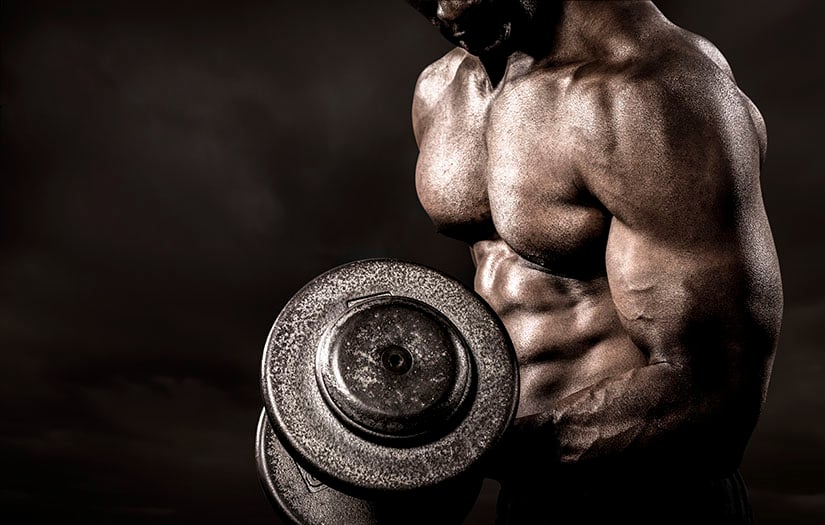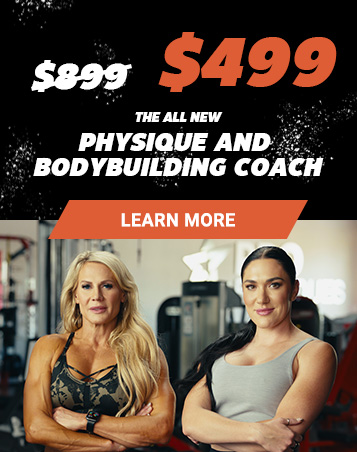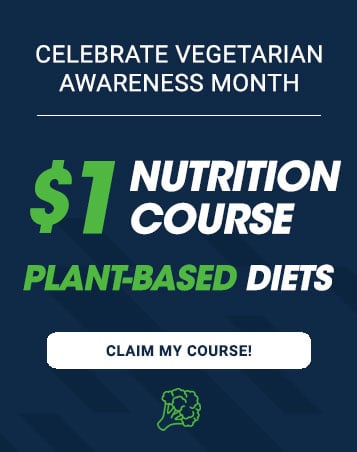The fitness industry is exploding, and it has become common for the average gym-goer or enthusiast to consider stepping on stage in a physique competition.
Many people begin with a transformational weight loss goal or to build muscle, and ultimately fall in love with the journey. Whether you are young or old, male or female, the divisions and levels of bodybuilding competition have expanded and there are many categories to choose from.
Want to gain the necessary knowledge to work in the bodybuilding realm? Try the NASM Physique and Bodybuilding Coach course.
Ready to Compete? Choose a Competition
As a coach, it is vital to recognize that this can become overwhelming to a new competitor, and it is imperative to help guide the athlete into the right competition and division.
Let’s start by breaking down the different levels of competition and various divisions by focusing on the premier bodybuilding and physique competition league, the NPC/IFBB (National Physique Committee and International Federation of Bodybuilding Pro League).
Here are the basic competition levels:
• Amateur, Regional Shows
• Amateur, National Qualifier Shows
• Jr. National Shows
• National Shows – Pro Qualifier
• IFBB Pro Shows (tier 1, 2, 3…)
• IFBB International Shows (i.e., Arnold Classic)
• IFBB Mr. Olympia Contest
Starting at the amateur level there are multiple divisions an athlete can participate in as follows:
• Women’s Bikini
• Women’s Wellness
• Women’s Figure
• Women’s Fitness
• Women’s Physique
• Women’s Bodybuilding
• Men’s Physique
• Men’s Classic Physique
• Men’s Bodybuilding
Within those divisions as an amateur, it is possible to compete in any of the following that apply:
• True Novice
• Novice
• Teen/Collegiate
• Open
• Masters
• Wheelchair
Assessing Your Bodybuilding Clients’ Readiness
It is best for coaches to assess an athlete’s current physical condition (aesthetics, body composition, muscle development, bloodwork, etc.) against the requirements of their ideal division. Based on experience, the coach can then advise approximately how long the athlete may need to achieve peak condition. This will help select a show based on the length of the competition prep and timing.
A good rule of thumb to maintain skeletal muscle mass (SMM) while reducing percent body fat (PBF) is to drop around 1-2 lbs/week and 0.5-1% BF per week.
For example, a female athlete that needs to drop 15 lbs and starts at 23% BF could realistically achieve bikini division goals in 12 weeks at her optimal bodyweight with an improved body composition around 10%.
Too fast of a cut increases risk of muscle wasting and athlete burnout, whereas too slow of a cut risk not reaching peak condition in time. This should be closely monitored by the coach on a weekly basis and adjusted as needed for each specific athlete by manipulating nutrition, training, cardio, and supplements.
What is Your “Why”?
This just might be the most important aspect of any competitor’s journey: Why do you want to compete?
It is essential to ground yourself in the love of the process of reaching your goals with an infinite mindset of continuous improvement and having fun. Everyone’s motivation is different and can evolve over time. For some, it is an intrinsic motivation they are born with and a thirst for competition (think MJ in the last dance). For others, it is about setting a goal to give themselves accountability and structure.
The darker side of the sport is relying solely on external validation from placings, social media, and trophies to fuel your motivation which is short-lived and not sustainable. The reality is many competitors only see and hear what the mind wants them to. In doing so they can become body dysmorphic, have interruptions with social life or relationships, and a generally bad attitude.
For this reason, it is important for the coach to help recognize and acknowledge athlete progress, celebrate both wins and losses, and have a safe and open environment to communicate how they are feeling. This requires good emotional intelligence by both the coach and athlete.
8–12 Weeks from Competition
Often, athletes may need to spend several months in an improvement phase prior to entering competition prep which is really the cutting and re-composition phase. It is common for athletes to spend time developing more muscle to enhance lagging areas, reverse dieting post-show, or doing a metabolic training phase before choosing the next competition.
The last 8-12 weeks of competition prep requires close communication between athlete and coach weekly, body composition and muscular development assessments, adjustments based on how the athlete is feeling emotionally, accountability, focus, and full transparency during check-ins. It is also essential to start practicing the mandatory poses and an individual routine. I cannot stress this enough and posing is commonly overlooked.
Although there are 4-5 key judging criteria from muscularity, conditioning, stage presence, symmetry etc. – these are all influenced by how we present them through our posing on stage.
Think About Your Weight Loss Goals and Milestones
Weight goals should be strategic and linear as part of the competition roadmap heading into the stage. Set milestones and celebrate wins. However, bodyweight and BMI alone do not tell the full story.
For categories that require weigh-ins, then the bodyweight holds more value than categories such as bikini or men’s physique where there is no weight requirement. When a specific bodyweight goal is required, the coach should work backwards from the contest date to calculate how many pounds per week must be dropped and decide if that seems reasonable.
The more important proxy for athlete progress is body composition. This will reveal proportions of skeletal muscle mass, dry lean mass, water, and percent bodyfat. When using a segmental lean analysis (i.e., DEXA scan or InBody 570) it will also reveal muscle proportions, symmetry and where the body fat is being stored.
This helps the coach guide the athlete more strategically in the gym and in exercise programming. In this scenario, bodyweight, SMM, water and PBF can be graphically illustrated to observe trends over time and adjust the prescribed plan accordingly.
Are Supplements Necessary for Becoming Competition Ready?
Supplements as with anything tend to get a bad rep due to misinformation, pseudoscience, and abuse. Supplements are one of the most important variables to adjust throughout a competition prep and will help aid in overall health and performance. With a restricted or narrow diet, it is important to monitor any nutrient deficiency or toxicity.
We can break dietary supplements into two major categories:
1) Daily health supplements
2) Performance supplements
For daily health, a few of my favorite recommendations are an encapsulated or powder multivitamin, omega-3 fish oil, superfood greens, liver/kidney detox, dietary fiber.
When it comes to performance supplements, many athletes prefer to add a fat-burner, micronutrition support for the thyroid, creatine, essential amino acids, and whey protein. When used properly, this combination can help increase muscle retention and decrease body fat mass. Other optional supplements like pre-workout may also help increase protein synthesis, blood flow, energy, recovery and more.
Try to avoid harsh stimulants, excessive caffeine, and oral supplements that are hard on the liver and kidneys. With the high stress of intense training and exercise induced muscle damage, Creatinine Kinase (CK) levels can elevate, and these factors combined place unnecessary stress on the adrenal glands and kidneys. (Not to mention potential sleep interruptions which also affect recovery).
See the NASM Guide to Micronutrients for more information on micros as a whole.
Peak Week
Peak week is another area that should be closely monitored with evidence-based practices for optimal nutrition and avoid harsh supplements such as medical grade loop or potassium sparing diuretics, or anything that increases health risks. By following the science-based approach offered in the NASM Physique and Bodybuilding course, safe and effective methodologies can be applied to naturally encourage increased muscle glycogen and diuresis of extracellular water.
Of course, I would be remiss if we did not mention the use (or abuse) of anabolic steroids and androgenic compounds. We do not condone the use of self-prescribed anabolics and prohormones due to the long list of side-effects and potential health risks. However, as a coach it is necessary to be knowledgeable and understand what implications this could have on the athlete.
Hormones in general play one of the most significant roles in determining the ability to build muscle, get lean, energy, libido, mood/motivation, and especially muscle nitrogen retention and protein synthesis. As a coach, it is your responsibility to refer the client to a medical professional and encourage frequent bloodwork to monitor key health indicators, hormones, and opportunities to optimize overall health.
Diet/Eating When on Prep:
• When cutting, maintain a mean caloric deficit of 500-1000 cal/day
• Break meals up into 4-6 portioned meals per day depending on your schedule
• Eat every 2.5-3 hours to help increase metabolism and remain anabolic
• Pre-workout: Carb | Protein | Fats ratio = 15:5:2
o Consume 60-90 mins before workout
• Intra-workout: Consume 5:1 carbs to essential amino acids
• Post-workout: Carb | Protein | Fats ratio = 2:3:1
o Consume 30-60 mins after workout
Typical Exercise Routines
Exercise routines will vary significantly depending on the athlete’s starting point and specific goals or division requirements.
For beginners or athletes needing to increase core and joint stabilizers, one option is to spend some time each week in the stabilization and strength endurance phases. This will help increase muscular endurance and work capacity for subsequent phases of training.
When it comes to experienced athletes on prep, it is most common to train between Phases 3 – 5 of the NASM (OPT) model, spending most of the time in the Muscular Development (Strength Hypertrophy) phase. Within this phase, tactics such as progressive overloading, exercise selection, and undulating periodization will help avoid plateaus and keep the athlete progressing towards their aesthetic physique goals.
On average, most competitors will need to train 4-6 times per week for 60-90 mins and increase cardio as they get closer to the contest date. It is common to target each primary muscle group 1-3 times per week.
Example Women’s Wellness Training Split – Goal for more muscular thighs, glutes and delts:
Monday – Lower Body, high-tension (hypertrophy
Tuesday – Upper Body, high-tension (hypertrophy)
Wednesday – Rest Day, cardio only
Thursday – Glutes and Delts Isolation (hypertrophy)
Friday – Back and Arms, metabolic conditioning
Saturday – Lower Body, metabolic conditioning
Sunday – Rest Day
*May integrate corrective exercise and cardio into warm-ups as needed.
Divisions that require more muscular development or lower percent body fat may require higher training and cardio volumes per week to achieve the requirements. For instance, a women’s physique competitor will require greater stimulus on the muscles, higher frequencies, more complex training splits (factoring in recovery) and more cardio than a bikini competitor.
Any muscular deficiencies or lagging areas can be prioritized at the beginning of the workout, or at a higher frequency per week to create the necessary muscle adaptations.
Mental Toughness for Competitors
Our feelings are based on how we emotionally respond when something happens. Our behaviors are based on how we act when something happens. The degree and resilience of what we think when things happen is mental toughness.
S.T.O.P. - Effective strategies to attain maximum impact and mental toughness:
STRATEGY 1: STOP
Stop and assess what you need for success while anticipating adversity. What's your why? Don't
rely solely on extrinsic (external) motivation. How will you navigate obstacles and celebrate wins?
STRATEGY 2: THOUGHTS
Identify and reframe unproductive (negative) thoughts through practicing more productive
(positive) thoughts using mindset strategies such as affirmations, prayer, and mantras
STRATEGY 3: OPTIONS
Merge unconditional positive regard and mindfulness daily by assessing your well-being, what's coming up for you and accept where you are without judgement.
STRATEGY 4: PIVOT
Prioritize mental and physical well-being through emotional processing, balanced nutrition,
regular exercise, adequate sleep, and hydration. Tap into your intrinsic (internal) motivation and
purpose.
Summary
The best piece of advice I can give any new competitors is to identify your “why,” do your research on the costs and time commitment associated with competition prep and find a credible prep coach. Having (or being) a knowledgeable coach that has synergies with the athlete will be a huge part of the athlete’s experience and success on stage. Athletes should be coachable and consistent, but also not afraid to communicate when something doesn’t feel right, make mistakes, and grow.





-1.png?width=723&name=MicrosoftTeams-image%20(4)-1.png)











